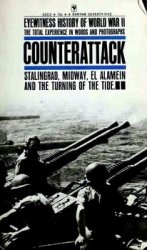Just as the tank attack at Cambrai revealed the method the British would use for the great offensives of 1918, so the Germans’ counterattack was a test of the methods they would develop for their offensives in the spring of that year.
The Germans were being organized into assault {Stoss) divisions. The infantry used light machine guns and light mortars, together with flamethrowers, to seek out and attack weak spots in the British line. These specially chosen soldiers were trained to infiltrate the defenses and to avoid pushing the enemy line back. Strong points were bypassed and left for the follow-up units. The objective was always the artillery positions which, if overrun, would prevent the enemy’s withdrawal to a new defense line.
The German infantry manhandled light artillery pieces forward to provide constant supporting fire. Aircraft gave close support to infantry. It was the first example of “battle groups,” mixed teams working in very close cooperation. Tanks had no place in these tactics, which did not have the same dramatic impact that the tank displayed and so did not get the same attention. But this new tactical method revolutionized warfare and was not far short of what was later called “blitzkrieg.”
Such infantry tactics, modified according to local conditions, were used by the Germans on all fronts. Especially noteworthy was the victory gained in November 1917 at Caporetto against the Italians. Rommel, then a young captain in the German Army, had received his Pour le Merite after his battalion had captured 9,000 prisoners and 81 guns at Caporetto. In 1940 he was to win world fame in command of a panzer division.
More British tank-led battles were fought, notably at Hamel, Amiens, and Albert, while the French (who had by now developed tanks of their own) used armor in the St.-Mihiel and Meuse-Argonne offensives.
As long as the tank moved at a slow walking pace, there would always be enough time for the Germans to move up their reserves and re-form a defense line. Obviously something faster was needed to exploit the breakthrough, but the cavalry proved so vulnerable to small-arms fire that it was useless in this role. Armored cars, less vulnerable to machine guns, were not organized or equipped for such work. Crews were not trained to do it and there were not enough such cars. In any case, they depended too much upon undamaged roads. And German gunners were learning how to knock out tanks, and their engineers were learning how to build better traps and ditches to disable them.
The great tank-led battle at Amiens in August 1918 is often said to be the battle in which the tank won the war. But, after an initial advance of no less than 12 miles, aided considerably by a heavy mist over the battlefield, the Allies still could not break through the front. During the first four days of battle the Tank Corps was almost wiped out as a fighting force, having lost 72 per cent of its tanks (from various causes).
The Germans had rejected the idea of tanks because of the scarcity of the material needed to manufacture them. By the end of the war, only a few rather crude models had come from the German factories.
BLITZKRIEG
And some captured Allied tanks were also used in battle. The Germans had no alternative but to fight the tanks with artillery; and this they did with notable success. As 1918 wore on, the Germans were knocking out tanks faster than British factories could manufacture them. In spite of frantic efforts made by base workshops, fewer and fewer Allied tanks were available to fight. In sixty-four days after the start of the Amiens battle, the number of tanks lost was equal to 41.4 per cent of Britain’s entire production up to that time, including those assigned to training, and even those for which contracts had been signed but which were not so far made.
By October 1918 the Tank Corps was counting its machines on the fingers of one hand: four tanks were available at the Selle River on 20 October and three at Maubeuge on 2 November. By 5 November the Tank Corps, with only eight tanks left, admitted that it was at the end of its resources.
The French and the Americans were in no better position. On the Argonne-Champagne front, for instance, they had lost 367 French and 70 American tanks. (Of these 22 per cent were lost to artillery fire, 2 per cent to mines, 20 per cent were captured, and 56 per cent had mechanical failures.) Crew casualties were about 40 per cent. The final week of the war was fought without tanks.
Ludendorff’s greatest concern during September 1918 was not the tank, nor even the Western Front; it was a series of events that had started with the loss of Jerusalem to General Sir Edmund Allenby in December. 1917 and ended with the destruction of the last Turkish army at Megiddo in September 1918. Allied armies at Salonika were also on the move and, at the end of September, the Bulgarians signed a separate peace with the Allies. Without sufficient armies to protect Germany against this new threat, Ludendorff advised his government to ask for an armistice. The war was coming to an end.
Whatever had brought an end to the var, it was not the tank. The Royal Navy had probably made the most vital contribution to Allied victory. The U-boat had been countered and the sea lanes kept open to supply the Allies with food and munitions while blockading Germany to a point of starvation. When America’s participation tilted the scales against the Germans, it was the Royal Navy which guaranteed that the American soldiers would arrive.




 World History
World History









